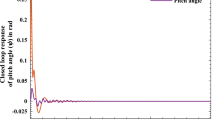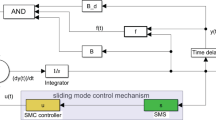Abstract
In practice, the unbalanced mass of the propeller is the leading cause of vibration in a quadcopter. Therefore, this paper proposes an additive-state-decomposition notch dynamic inversion controller to suppress the vibration noise. Firstly, the vibration mechanics model based on unbalanced mass is established and its characteristic frequency is analyzed. Then, the specific form of the notch filter is designed, and this characteristic frequency is taken as its internal parameter. Next, stability analysis shows that the proposed controller guarantees that all attitude signals are globally uniformly ultimately bounded. In particular, the notch filter can effectively reduce the vibration having a specific frequency. Finally, the proposed controller is performed on a real quadcopter to verify its vibration reduction performance.













Similar content being viewed by others
Data Availability Statement
The datasets generated during and/or analyzed during the current study are available from the corresponding author on reasonable request.
References
Quan, Q.: Introduction to Multicopter Design and Control. Springer Singapore, Singapore (2017)
Maj, C.R.: A novel approach to vibration isolation in small, unmanned aerial vehicles. In: IEEE International Conference on Technologies for Practical Robot Applications, pp. 84–87 (2009)
Gwak, D.Y., Han, D., Lee, S.: Sound quality factors influencing annoyance from hovering UAV. J. Sound Vib. 489(22), 1 (2020)
Miljkovic, D.: Methods for attenuation of unmanned aerial vehicle noise. In: IEEE International Convention on Information and Communication Technology, Electronics and Microelectronics, pp. 914–919 (2018)
Ghalamchi, B., Jia, Z., Mueller, M.W.: Real-time vibration-based propeller fault diagnosis for multicopters. IEEE/ASME ASME Trans. Mechatron. 25(1), 395 (2019)
Niemiec, R., Gandhi, F., Kopyt, N.: Relative rotor phasing for multicopter vibratory load minimisation. Aeronaut. J. 126(1298), 1 (2022)
Tu, W., Yu, W., Shao, Y., Yu, Y.Q.: A nonlinear dynamic vibration model of cylindrical roller bearing considering skidding. Nonlinear Dyn. 103, 2299–2313 (2021)
Hu, Q.L.: Robust adaptive sliding mode attitude maneuvering and vibration damping of three-axis-stabilized flexible spacecraft with actuator saturation limits. Nonlinear Dyn. 55, 301–321 (2009)
Mousavi, Y., Alfi, A., Kucukdemiral, I.B., Fekih, A.: Tube-based model reference adaptive control for vibration suppression of active suspension systems. IEEE/CAA J. Autom. Sinica 9(4), 728 (2022)
Capriglione, D., Carratù, M., Catelani, M., Ciani, L., Patrizi, G., Pietrosanto, A., Sommella, P.: Experimental analysis of filtering algorithms for IMU-based applications under vibrations. IEEE T. Instrum. Meas. 70, 1 (2020)
Online, Vibration Damping https://ardupilot.org/copter/docs/common-vibration-damping.html (2016)
Zhang, C., Ma, G., Sun, Y.: Prescribed performance adaptive attitude tracking control for flexible spacecraft with active vibration suppression. Nonlinear Dyn. 96, 1909–1926 (2019)
Bian, Y., Gao, Z., Yun, C.: Study on vibration reduction and mobility improvement for the flexible manipulator via redundancy resolution. Nonlinear Dyn. 65, 359–368 (2011)
Zhang, J., Du, G.X., Quan, Q.: Initial research on vibration reduction for quadcopter attitude control: An additive-state-decomposition-based dynamic inversion method. In: IEEE Chinese Automation Congress (CAC), pp. 1–6 (2017)
Quan, Q., Cai, K.-Y.: Additive decomposition and its applications to internal-model-based tracking. In: IEEE Conference on Decision and Control, pp. 817–822 (2009)
Wei, Z.B., Quan, Q., Cai, K.-Y.: Output feedback ILC for a class of nonminimum phase nonlinear systems with input saturation: an additive-state-decomposition-based method. IEEE Trans. Automat. Contr. 62(1), 502 (2017)
Ren, J.R., Quan, Q., Ma, H.B., Cai, K.-Y.: Additive-state-decomposition-based station-keeping control for autonomous aerial refueling. Sci. China Inform. Sci. 64(11), 1 (2021)
Ren, J.R., Quan, Q., Zhao, L.B., Dai, X.H., Cai, K.-Y.: Two-degree-of-freedom attitude tracking control for bank-to-turn aerial vehicles: an additive-state-decomposition-based method. Aerosp. Sci. Technol. 77, 409 (2018)
Nakamura, Y., Kawamura, A., Iiguni, Y.: An adaptive notch gain using an inverse notch filter and a linear prediction filter. Electron. Commun. Jpn. 100(2), 58 (2017)
Quan, Q., Dai, X.H., Wang, S.: Multicopter Design and Control Practice. Springer Singapore, Singapore (2020)
Quan, Q., Du, G.X., Cai, K.-Y.: Proportional-integral stabilizing control of a class of MIMO systems subject to nonparametric uncertainties by additive-state-decomposition dynamic inversion design. IEEE ASME Trans. Mechatron. 21(2), 1092 (2016)
Hassan, K.K.: Nonlinear Systems. Prentica Hall, Michigan State University, Upper Saddle River (1996)
Quan, Q., Cai, K.-Y., Lin, H.: Additive-state-decomposition-based tracking control framework for a class of nonminimum phase systems with measurable nonlinearities and unknown disturbances. Int. J. Robust Nonlinear Control 25(2), 163 (2015)
Åström, K.J., Wittenmark, B.: Computer-Controlled Systems: Theory and Design. Courier Corporation, New York (1997)
Wang, S., Dai, X.H., Ke, C.X., Quan, Q.: A rapid multicopter development platform for education and research based on Pixhawk and MATLAB. In: IEEE International Conference on Unmanned Aircraft Systems, pp. 1–8 (2021)
Quan, Q., Cai, K.-Y.: Repetitive control for nonlinear systems: an actuator-focussed design method. Int. J. Control 94(5), 1 (2019)
Funding
This work was supported by the National Natural Science Foundation of China under Grant 61973015.
Author information
Authors and Affiliations
Corresponding author
Ethics declarations
Conflict of interest
The authors declare that they have no conflict of interest with the present manuscript.
Additional information
Publisher's Note
Springer Nature remains neutral with regard to jurisdictional claims in published maps and institutional affiliations.
Appendix A
Appendix A
1.1 Proof of Theorem 1
Under Assumption 4, the closed-loop system composed of (12), (22) and (45) is described as
Let \({{\gamma }_{1}}\) be the smallest eigenvalue of the positive definite matrix \({\textbf{M}}\), one obtains
Define a candidate Lyapunov function \(V={{{\textbf{x}}}^{\text {T}}}\textbf{Px}+{{{\textbf{v}}}^{\text {T}}}{\textbf{v}}\). Taking the derivative of V along the solution of (52) yields
Substituting (52) and (53) into (54) results in
Under Assumptions 1–2, the following results are gained:
where
Then, substituting (56) into (55) yields
Based on Lemma 2 of Ref. [21], \({\textbf{h}}\) is rewritten as
Assumption 1 implies that \(\left\| \varvec{\sigma } \right\| \le {k}_{\sigma }\left\| {\textbf{x}} \right\| +{{\bar{\delta }}_{\sigma }}\); then, one has
Substituting (60) into (58) results in
where
Since the inequality \(ab\le {\left( {{a}^{2}}+{{b}^{2}} \right) }/{2}\;\) holds, \(2{\gamma _3}\left\| {\textbf{v}} \right\| \left\| {\textbf{x}} \right\| \) satisfies the following inequality:
Assume that
where \({{\lambda }_{\max }}\left( {\textbf{P}} \right) \) denotes the maximum eigenvalue. Then substituting (63) into (61), one has
where \({V_\varepsilon }={{\bar{\delta }}_{\sigma }}{{l}_{{{\text {J}}_{t}}}}+{{\bar{\delta }}_{\sigma }}\left( 1+{{{{\bar{l}}}}_{{{\text {J}}_{\varDelta }}}} \right) {{\bar{\delta }}_{q}}+\left( 1+{{{{\underline{l}}}}_{{{\text {J}}_{\varDelta }}}} \right) {{{\bar{d}}}_{\sigma }}\). If (46) is satisfied, then \(\eta \left( \varepsilon \right) >0\). For any initial condition \({\textbf{x}}_0\), the values \({\varvec{\delta }_{\sigma }}\left( t \right) \), \({\varvec{d}_{\sigma }}\left( t \right) \), \({\varvec{\delta }_{q}}(t)\) have upper bounds \({{\bar{\delta }}_{\sigma }}\), \({{\bar{d}}_{\sigma }}\), \({{\bar{\delta }}_{q}}\), respectively, the state vector \({\textbf{x}}\) satisfies
where \({\mathcal {B}}\left( \delta \right) \overset{\varDelta }{\mathop {=}}\,\left\{ \xi \in {\mathbb {R}}|\left\| \xi \right\| \le \delta \right\} ,\delta >0\). This implies that the state vector \({\textbf{x}}\) in the closed-loop system (52) is globally uniformly ultimately bounded. This completes the proof of Theorem 1.
1.2 Proof of Corollary 1
Let us consider that the controlled system (12) is simplified into a class of linear system (47) with specific frequency disturbance \(\varvec{\sigma } \left( t,\omega _{0} \right) \). Assume that the disturbance signal \({{\varvec{\sigma }}\left( t,\omega _{0} \right) }\) is a cosine signal vector with frequency \(\omega _{0}\). Let \(\varvec{\sigma }\left( t, \omega _{0} \right) ={{{\textbf{1}}}_3}\cos \left( \omega _{0} t \right) \), where \({{{\textbf{1}}}_3} \in {\Re ^3}\) denotes a column vector whose elements are all ones, without loss of generality. According to the frequency retention characteristics of the linear system, its Laplace transform is expressed as
Each steady-state variable in the dynamic equation (47) must contain a cosine signal with a frequency of \(\omega _{0}\). Suppose that these states are expressed as
where \({\alpha }_{1}, {\alpha }_{2},\ldots , {\alpha }_{6}\) denotes the amplitudes, \(\bar{\varphi }_{1}, \bar{\varphi }_{2}, \ldots , \bar{\varphi }_{6}\) are phase. Then, the newly defined steady-state output \({\textbf{y}}_{\text {ss}}\) is expressed as
where \(\alpha _{i}^{L}\) is a new amplitude, and \({{\varphi }^{'}_{i}}\) is a new phase delay, \(i=1, 2, 3\). Substituting (69) into (39) results in
Since \({\textbf{x}}_{ \text {ss}}\left( s \right) \) contains some sinusoidal time-varying signals, the control signal will have the following component:
According to the conclusion of Ref. [26], if two \(\frac{s}{{{s^2} + \omega _{0}^2}}\) are connected in series, the transfer function will be unstable, that is, the system will diverge. However, Theorem 1 implies that the control signal is bounded, so a contradiction appears. Therefore, it is inferred that the state vector \({{\textbf{x}}}\left( t \right) \) cannot contain the disturbance signal with the frequency \(\omega _{0}\). Similarly, in a linear system, the controller (38) with \({\textbf{Q}}\left( s \right) \) shown in (37) can completely suppress the disturbance \({{\varvec{\sigma }}\left( t,\omega _{0} \right) }\) having only constant and specific frequency \(\omega _{0}\) components, namely, \(\underset{{t}\rightarrow 0}{\mathop {\lim }}\,\left\| {\textbf{x}}(t) \right\| = {\textbf{0}}\). This completes the proof of Corollary 1.
Rights and permissions
Springer Nature or its licensor (e.g. a society or other partner) holds exclusive rights to this article under a publishing agreement with the author(s) or other rightsholder(s); author self-archiving of the accepted manuscript version of this article is solely governed by the terms of such publishing agreement and applicable law.
About this article
Cite this article
Chen, L., Zhang, J. & Quan, Q. Quadcopter attitude control with vibration reduction by additive-state-decomposition dynamic inversion design with a notch filter. Nonlinear Dyn 111, 8313–8327 (2023). https://doi.org/10.1007/s11071-023-08272-6
Received:
Accepted:
Published:
Issue Date:
DOI: https://doi.org/10.1007/s11071-023-08272-6




